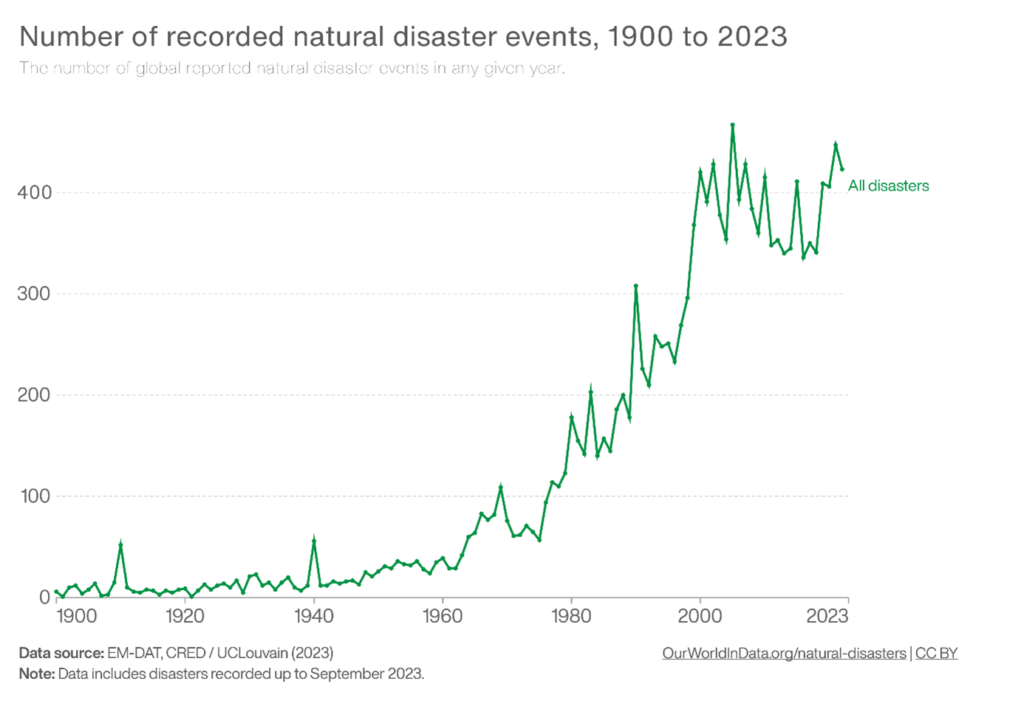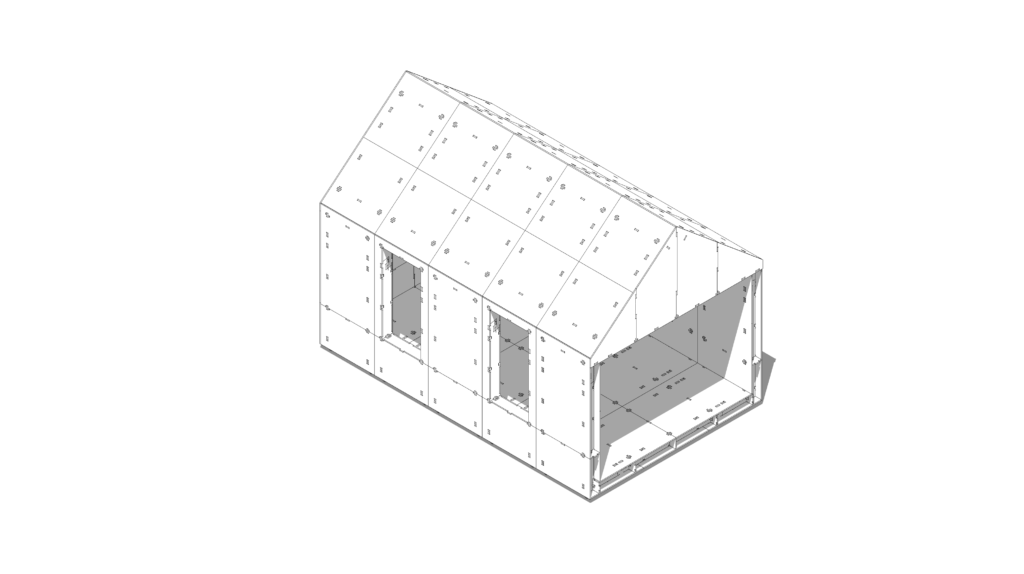As we move further into the 21st century, our chances of averting climate change have all but disappeared. Analysis shows that global temperatures now sit 1.1? above pre-industrial levels and are set to rise to 1.5? by the early 2030s (Jotzo and Howden, 2023). This rapid increase in temperatures has led to loss of land through rising sea levels and an increase in climate catastrophes. Disasters linked to these kinds of weather extremes have always been a part of the Earth’s system, but the rate of change has led to them becoming more frequent and intense, leading to the destruction and loss of people’s homes (United Nations, 2020). Concerns have been raised about the suitability of emergency shelter, stating that they’re often ad hoc, lack health and safety protections, and leave those displaced stranded for extended periods of time (Dopraz-Dobias, 2022). With a recent study stating that these kinds of events are set to destroy 167 million homes globally by 2040 (ShelterBox, 2021), the need for an innovative solution is paramount.

Figure 01: Graph showing the rate of increase in natural disasters over time (Ritchie et al, 2023).
One potential solution to this could be open-source architecture. Open source “refers to something people can modify and share because its design is publicly accessible” (Arora, 2019) with the movement beginning in the Technology sector in the 1960’s (Raymond, 2023). In recent years, the concept has gained traction within the architectural community with firms such as ELEMENTAL releasing the rights to some of their designs (Overstreet, 2022). For the most part, this is aimed at tackling the challenges around housing shortages and affordability through facilitating a “Do It Yourself” approach; utilizing the rise of the internet to disseminate this information whilst removing the need for experts in the design and construction process (Overstreet, 2022).

Figure 02: Example of Wiki House Open source Design.
For all its merits, Open-source architecture has several key limitations which must be addressed for it to become a viable solution in combatting the issues surrounding post-disaster accommodation. One of the main concerns surrounds adaptation to local climates; stating that without the integration of sustainable design tools, these buildings would not achieve basic levels of comfort (Chambers, 2012). Another issue is matching the design to local materials and construction processes with the capability of ensuring structural integrity; without this access to designs could prove futile. Finally, the current designs do not facilitate individual adaptations, which would mean they might not accommodate the full socio-dynamic needs of different disaster victims.

Figure 03: Analysis showing WikiHouse performance in different countries and climates (adapted from Chambers, 2012).
The answer to this could be a platform which combines novel computational techniques with a simplified user interface to provide victims with a bespoke solution to their need for shelter:

Figure 04: Open Source Design Platform
Platform – a platform could be developed that allows users to access analysis without the need to be an expert. One good example of this is Autodesk’s Forma, which “gives architects and developers the automation superpower to test design concepts in minutes” through the integration of generative design and artificial intelligence in a cloud-based solution (Harouk, 2020). This sort of approach could be integrated with an SQL material library – such as the building material scout in Germany, which would allow for the collection of data on physical environments and material specifications (Garcia et al, 2021). However, it’s been noted that this would require some initial input from experts. This aspect of the platform could work in a similar manner to the way Open Street maps functions, with volunteers simultaneously updating and verifying information (Open Street Maps, 2022).
Generative design – the integration of generative design would facilitate the individual adaptations required for comfort. Much like the rest of the technology sector, computational design software such as rhino and grasshopper have seen an explosion of open-source activity and data sharing (McNeel, 2023). Much of this activity is centered around analysis tools such as ladybug and honeybee, which allow for environmental testing and optimization and Karamba which facilities the testing of different materials and their structural implications (Preisinger, 2013). Integrating these plug-ins with general parametric principles would go a long way to solving some of the potential shortcomings of the contemporary open-source practice.
Material recognition, classification, and matching – One of the major problems with the current approach is the need to import exogenous materials to produce shelter which causes significant delays (Dopraz-Dobias, 2022). One solution for this would be to view the waste material of the ruined building stock as a resource. Python could be used to develop a machine learning model to recognize different materials using image recognition packages such as Mask R-CNN (He et al, 2017). A training data set could be developed by volunteers and then the model could be deployed. Machine learning packages such as TensorFlow could be used to match features of the materials to the output of the generative model and develop a of parts for the end user (Abadi et al, 2015).
AR instructions – removing the need for construction experts – Construction skills are often seen as an issue when developing open-source solutions to building design. The Steampunk pavilion is a good example of how this could potentially be overcome. The project utilized primitive hand tools augmented with the precision of intelligent holographic guides which made it possible for lay people to construct a complex structure (Pintos, 2019). This technique could be combined with the construction sequence developed from the kit of parts and the generative model to provide the end user with a construction manual.

Figure 05: Flow Diagram showing the potential to combine open source software to develop a solution
In conclusion, the increase in catastrophes due to climate change demands innovative, tangible solutions to provide victims with shelter. A democratized design process, facilitated through an open-source framework could prove to be a suitable solution in developing a new response in post-disaster accommodation. However, our research has revealed that while open-source architecture has vast potential, significant challenges demand nuanced resolutions. The proposed solution envisions a design platform, which would leverage novel computational techniques combined with an intuitive interface, promising the user a bespoke solution whilst also affording a level of control over the situation they face. Generative design and iterative feedback loops will provide that backbone that will facilitate individual’s needs, ameliorating the potential drawbacks of generic contemporary designs. Deploying machine learning for material recognition and classification, in combination with augmented reality build manuals, not only accelerates construction but also harnesses local resources, providing a solution to the long waiting times. The synthesis of these posses presents a theoretical framework with the potential to revolutionize disaster-responsive design, offering a tangible solution to the growing issue of post-catastrophe accommodation.
Bibliography:
Abadi, M. et al. (2015) ‘TensorFlow: Large-Scale Machine Learning on Heterogeneous Distributed Systems’. Available at: http://download.tensorflow.org/paper/whitepaper2015.pdf (Accessed: 3 December 2023).
Arora, M. (2019) ‘What is Open Source?’, Medium, 2 December. Available at: https://mudit-arora.medium.com/what-is-open-source-5112e64eeda2 (Accessed: 3 December 2023).
Chambers, N. (2012) Will Open Source Architecture Perpetuate Old Mistakes? – Metropolis. Available at: https://metropolismag.com/projects/open-source-architecture-perpetuate-old-mistakes/?fbclid=IwAR0wsPhUMTb_eeiWLn1Ruw1SwDrQfoX-jR_KJR3fe9665EJSTmTgp5nkEhw (Accessed: 3 December 2023).
Dopraz-Dobias, P. (2022) The New Humanitarian | Is emergency shelter fit for purpose? Available at: https://www.thenewhumanitarian.org/news-feature/2022/12/09/emergency-shelter-tents-climate-disaster-response-displaced-communities (Accessed: 3 December 2023).
Garcia et al. (2021) Material (data) Intelligence: Towards a Circular Building Environment — TU Delft Research Portal. Available at: https://research.tudelft.nl/en/publications/material-data-intelligence-towards-a-circular-building-environmen (Accessed: 3 December 2023).
Harouk, C. (2020) Spacemaker Proposes AI-Powered Generative Design to Create More Sustainable Spaces and Cities | ArchDaily. Available at: https://www.archdaily.com/952850/spacemaker-proposes-ai-powered-generative-design-to-create-more-sustainable-spaces-and-cities (Accessed: 3 December 2023).
He, K. et al. (2017) ‘Mask R-CNN’, in 2017 IEEE International Conference on Computer Vision (ICCV), pp. 2980–2988. Available at: https://doi.org/10.1109/ICCV.2017.322.
Jotzo, F. and Howden, M. (2023) Analysis: Latest IPCC report confirms climate change is worsening, but we have the tools to combat it, PBS NewsHour. Available at: https://www.pbs.org/newshour/science/analysis-latest-ipcc-report-confirms-climate-change-is-worsening-but-we-have-the-tools-to-combat-it (Accessed: 3 December 2023).
‘Mask R-CNN for Object Detection and Segmentation’ (2023). Matterport, Inc. Available at: https://github.com/matterport/Mask_RCNN (Accessed: 3 December 2023).
McNeel (2023) McNeel Forum. Available at: https://discourse.mcneel.com/ (Accessed: 3 December 2023).
Open street maps (2022) About OpenStreetMap – OpenStreetMap Wiki. Available at: https://wiki.openstreetmap.org/wiki/About_OpenStreetMap (Accessed: 3 December 2023).
Overstreet, K. (2022) Is There a Future for Open Source Architecture?, ArchDaily. Available at: https://www.archdaily.com/983160/is-there-a-future-for-open-source-architecture (Accessed: 3 December 2023).
Pintos, P. (2019) Steampunk Pavilion / Gwyllim Jahn & Cameron Newnham + Soomeen Hahm Design + Igor Pantic, ArchDaily. Available at: https://www.archdaily.com/926191/steampunk-pavilion-gwyllm-jahn-and-cameron-newnham-plus-soomeen-hahm-design-plus-igor-pantic (Accessed: 3 December 2023).
Preisinger, C. (2013) (4) Linking Structure and Parametric Geometry | Request PDF. Available at: https://www.researchgate.net/publication/264223448_Linking_Structure_and_Parametric_Geometry (Accessed: 3 December 2023).
Raymond, E. (2023) Open source | Definition, Hacker Culture & Linux | Britannica. Available at: https://www.britannica.com/topic/open-source (Accessed: 3 December 2023).
Ritchie, H., Rosado, P. and Roser, M. (2023) ‘Natural Disasters’, Our World in Data [Preprint]. Available at: https://ourworldindata.org/natural-disasters (Accessed: 3 December 2023).
ShelterBox (2021) Press release: Climate crisis to destroy 167 million homes in next 20 years, ShelterBox. Available at: https://shelterbox.org/news/press-releases/climate-crisis-to-destroy-167-million-homes-in-next-20-years/ (Accessed: 3 December 2023).
TensorFlow (2023) TensorFlow, TensorFlow. Available at: https://www.tensorflow.org/ (Accessed: 3 December 2023).
United Nations (2020) The Climate Crisis – A Race We Can Win, United Nations. United Nations. Available at: https://www.un.org/en/un75/climate-crisis-race-we-can-win?fbclid=IwAR1T-jdB5-WTOPMUskNUmLpnrXVAl0NHqYTSSy3zxZOv5e-Yb3BsBc0njOY (Accessed: 3 December 2023).

